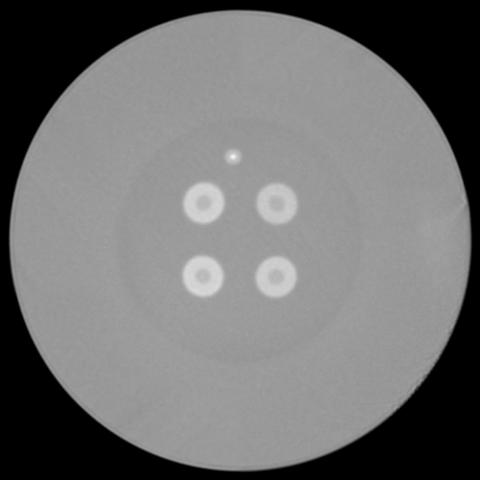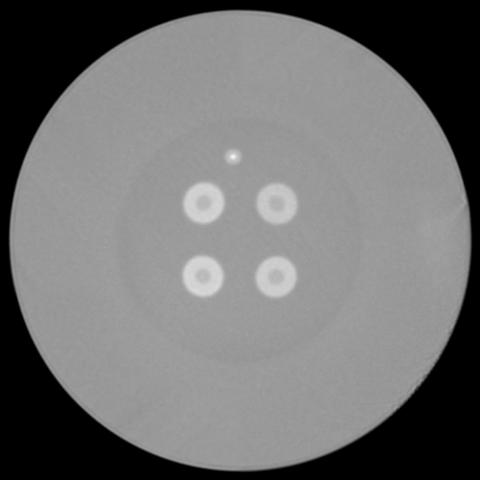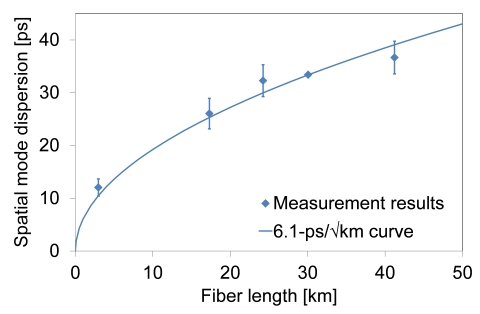OSAKA, Japan--(BUSINESS WIRE)--Sumitomo Electric Industries, Ltd. (TOKYO:5802)(ISIN:JP3407400005) has developed a new-type coupled multi-core optical fiber suitable for ultra-long-haul transmission, which has set new records of the low attenuation and the low spatial mode dispersion in the optical fibers for space division multiplexing.
The data network traffic in the long-haul transmission systems is growing due to the widespread uses of smartphones, data centers, and others; and the transmission capacity has been improved with the low-loss*1 single-mode fibers*2. At the same time, to realize the drastic improvement of the capacity, space-division multiplexing (SDM) has been intensively studied, and the multi-core fiber (MCF)*2 is expected as a next-generation optical fiber that can realize ultra-high-capacity transmission systems.
Sumitomo Electric has developed a coupled-core MCF (CC-MCF)*2 including 4 pure-silica cores in the standard 125-µm cladding. The developed fiber has achieved the attenuation*1 of 0.158 dB/km at the wavelength of 1550 nm and the spatial mode dispersion (SMD)*3 of 6.1 ps/√km*4 in the wavelength from 1520 to 1580 nm, both of which are the lowest ever reported in the optical fibers for space division multiplexing.
The ultra-low attenuation approaching that of the commercial ultra-low-loss single-mode fiber (SMF) enables signal transmission with lower noises than the previously-reported SDM fibers, and is expected to realize the spatial channel count increase without per-channel capacity degradation. The SMD of 6.1 ps/√km is one fifth the lowest SMD of the previously reported SDM fibers, and thus can reduce the calculation complexity of the multiple-input-multiple-output (MIMO) digital signal processing (DSP)*5 for the crosstalk compensation. Furthermore, the developed CC-MCF with the standard 125-µm-diameter cladding can be cabled with the existing cable designs for the standard optical fibers, and is expected to have the high mechanical reliability equivalent to that of the standard optical fiber.
Sumitomo Electric has produced many pioneering results*6 in the research and development on the MCF since 2009. Since 1980’s, it also has been developing and manufacturing the pure-silica-core fibers, and contributing to the developments of the submarine optical cable networks*7. The present achievement has been made by integrating these technologies.
Sumitomo Electric will continue the developments of various MCFs and related-technologies for their practical application.
These results will be presented at a postdeadline paper*8 session (6:00 pm on March 24, 2016, PDT) of Optical Fiber Communication Conference (OFC 2016, March 20–24, 2016, Anaheim, California, USA), one of the largest conferences on optical fiber communications.
*1: Attenuation, or (transmission) loss, is the amount of light degraded by scattering and absorption while traveling in an optical fiber. With a lower attenuation, optical signals can be transmitted for a longer distance. The lowest loss of the commercial optical fiber is 0.154 dB/km at 1550 nm, which is realized in the ultra-low-loss single-mode fiber for submarine transmission. The attenuation of the standard single-mode fiber is around 0.185 dB/km. The lowest attenuation of the previously-reported SDM fibers was 0.168 dB/km (averaged over cores).
|
*2: Types of optical fibers |
||
| Features | ||
| Single-mode fiber (SMF) | An optical fiber that has a thin (<10 µm) core. Only one optical path exists in the fiber. | |
| Standard optical fibers | Optical fibers standardized for various fiber optic communications including the SMF. The standard cladding (glass) diameter is 125 µm. | |
| Multi-core fiber (MCF) | An optical fiber that has multiple cores. There are “uncoupled” type and “coupled” type. | |
| Uncoupled MCF | An MCF that has the core-to-core crosstalk low enough for using each core as an isolated spatial channel. For the crosstalk suppression, the core-to-core distance has to be separated and the cladding diameter tends to become large. | |
|
Coupled MCF / coupled-core MCF (CC-MCF) |
An MCF that has short core-to-core distance and large crosstalk. The MIMO DSP is necessary for crosstalk compensation, but the CC-MCF can pack more cores in a smaller cladding than the uncoupled MCF. | |
| Multimode fiber (MMF) | An optical fiber that has a thick (>10 µm) core. Multiple optical paths (modes) exist in the core. The modal crosstalk is difficult to suppress and thus the MIMO DSP is necessary for crosstalk compensation in the SDM transmission. | |
*3: Spatial mode dispersion (SMD) is the amount of the time spread of the light pulse, induced by the optical path differences between multiple optical paths in an optical fiber. The lower SMD is preferable because the DSP calculation complexity can be reduced.
*4: “ps/√km” is the unit of the spatial mode dispersion in the coupled MCF, which represents the time spread (ps) of the signal pulse grows proportionally to the square root of the transmission distance (√km)—i.e., the SMD after 10,000-km transmission is 100 times (not 10,000 times) higher than that after 1-km transmission. On the other hand, the signal pulse spread (ps, ns) of the MMF grows proportionally to the transmission length (km) because mode coupling is weak. Thus the SMD unit becomes “ps/km,” “ns/km,” etc.
*5: Multiple-input-multiple-output (MIMO) digital signal processing (DSP) is the digital calculation that can compensate the crosstalk of the MCF and the MMF. Fully mixed signals can be untangled to the original individual signals.
*6:
National Institute of Information and Communications
Technology, Japan, “NICT Achieved Highest Capacity of 109 Terabit Per
Second Optical Fiber Transmission,” [Press release] (2011).
Sumitomo
Electric Industries, Ltd., “Sumitomo Electric Has Developed New-type
Multi-Core Optical Fiber for Optical Interconnects and Realized
Highest-Density Multi-Core Fiber Optic Cable,” [Press release] (2015).
http://global-sei.com/company/press/2015/03/prs022_s.html
National
Institute of Information and Communications Technology, Japan,
“Realization of World Record Fiber-Capacity of 2.15Pb/s Transmission,”
[Press release] (2015).
http://www.nict.go.jp/en/press/2015/10/13-1.html
*7:
Sumitomo Electric Industries, Ltd., “Sumitomo Electric has set
a New World Record of the Lowest Optical Transmission Loss and Starts
Shipment of Optical Fibers with Low Transmission Loss and Large
Effective Core Area Fibers,” [Press release] (2013). http://global-sei.com/news/press/13/prs032_s.html
*8: Postdeadline paper
The postdeadline papers are received after
the deadline of regular submissions. Generally, these papers present new
and significant materials in rapidly advancing areas. Only those papers
judged to be truly excellent and compelling in their timeliness are
accepted for presentation.






